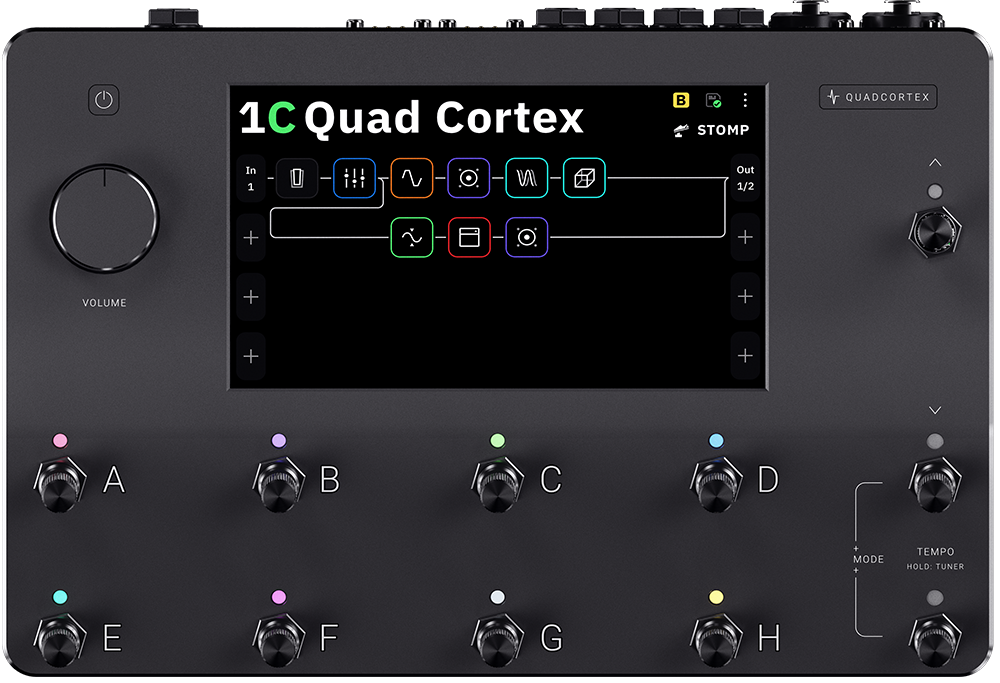The Neural DSP Quad Cortex is the most hyped piece of gear for guitarists right now. Neural have already garnered praise for their high-quality plugins, and their first foray into hardware appears to be a game-changer.
Neural DSP Quad Cortex pushes the boundaries
The Quad Cortex was announced during Winter NAMM 2020. Then in the beta stage, there was already much excitement regarding the technology inside the unit.
We learned early on that Neural discovered a way to use machine learning to make its amp and effects models better than anything currently out there. And while hardware amp sims have been around for some time now, the Quad Cortex has its feet firmly planted in the future.
Still, Quad Cortex faces stiff competition against the ever-popular Axe FX, the reliable Kemper, and the flexible Line 6 Helix. Here’s what we know about the unit.
- Related: Amp Sim Hardware and Plugins
Power and Features
What more could you want? Neural DSP boldly claims the Quad Cortex is ‘the most powerful floor modeler on the planet.’ That appears to be true, because the unit is built around 2GHz Quad-Core SHARC architecture.
Dedicated DSP is the heart of the unit, giving it ample realtime processing power. This means patches could get wildly complex, combining multiple amps and effects to create some truly unique sounds. 4 amps, stereo delays, and every modulator under the sun? Done and done, no sweat.
The 7″ touch display provides the ease-of-use we’d expect in hardware like this in 2021, so navigating the interface is intuitive. Then there’s built-in WiFi that can be used for wireless patch sharing, cloud backups, firmware updates, and more.
At launch, the modeler comes with over 50 amps, 70 effects, and 1000 IRs, which is enough to make your head spin. On the front of the unit are 11 footswitches and one large Volume dial. These switches are multi-purpose; you can stomp them to turn effects on/off or change patches, but you can also twist them to control virtual knobs on the amp and effects models.
Finally, the whole thing is packaged in a compact, sturdy aluminum enclosure weighing just 4 pounds. For comparison, its overall dimensions are smaller than a 15″ MacBook Pro. Throw it in a backpack and you’ve got yourself an all-around unit for live performance and the studio.
Neural Capture
Neural Capture is a key feature of the Quad Cortex which could set it far apart from competitors. It allows users to capture, share, and download any rig’s sounds. It sort of like Kemper technology in that regard, but aims to take that idea a step further.
Neural DSP uses its own biomimetic AI technology which allows the Quad Cortex to learn and replicate the sonic characteristics of any physical amplifier, effect, or cabinet.
IRs and EQ
The Neural DSP Quad Cortex gives you over 1000 impulse responses to play with, as well as a parametric EQ to shape the tone further. On paper, the unit should have more than enough ways for users to set up their own advanced virtual rig.
If you have your own reliable favorites, you can of course upload third-party IRs for use in the Quad Cortex.
I/O
The Quad Cortex covers just about every scenario with a thoughtfully extensive I/O selection. It comes with dual Neutrik combo inputs for TS, TRS, or XLR. Those get variable impedance and level controls, with built-in microphone preamps and phantom power. Then there are dual effects loops for adding external mono/stereo effects to your chain.
You get a pair of 1/4″ outs, a pair of XLR outs, MIDI in and out/thru, dual expression pedal inputs, headphone out, and USB. It’s all there, ready for every situation and use.
Modes
There are three main modes available to users.
- Stomp Mode: Assign and activate any block in a rig to a footswitch like you would with an analog pedalboard.
- Scene Mode: Select any footswitch to instantly activate and control the settings of any number of blocks within a rig.
- Preset Mode: Instant access to 8 virtual rigs.
Neural DSP Quad Cortex: Conclusion
The Neural DSP Quad Cortex is shaping up to change what we expect from from amp modelers. It combines raw power with intuitiveness that we’d hope to see in a product like this in 2021.
The biggest challenge right now seems to be getting your hands on one.
